| |
GEM TALE |
|
| |
The
story of precious gems begins over four thousand years ago in Egypt, just
south of Cairo near the Aswan Dam, in a place called "Cleopatra's
Mine." Although emeralds were mined for two thousand years before
Cleopatra was born, her passion for the glittering green jewel is responsible
for the mine's name.
Emerald earrings set in gold sometimes depicting
a sacred scarab, symbolizing the soul dangled from Cleopatra's royal earlobes.
Her fingers were often adorned with the magical verdant stone, which she
believed would guarantee her immortality. And atop her royal head, the
queen of the Nile wore a diadem featuring the goddess Isis, bestowing
power upon her and protecting her from evil.
|
|
| |
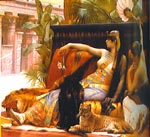 |
|
In
ancient Egypt, green signified growth and new life. When Cleopatra took
her own life rather than surrender to Octavian, she surrounded herself
with, among other gems, a bounty of emeralds. Emeralds, she was certain,
would ensure her success in her next life. The emerald is the oldest known
true gemstone.
|
|
| |
The allure of gems is one of the world's
universal mysteries. Sumptuous stones have inspired and exhilarated every
culture and civilization throughout the ages. Long before any monetary
value could be ascribed to them, gems were highly prized possessions,
used to denote status and wealth.
In ancient times, gems were viewed as gifts
from the gods, the privilege of royalty. Historically, gems were coveted
not only for their beauty, rarity and worth the ancients attributed magical,
talismanic and healing powers to gems.
|
|
| |
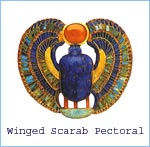 |
|
In
the Old Testament's Book of Exodus, God instructed Aaron to wear a breastplate
adorned with gems for protection as he led the Jews out of Egypt. Along
with Cleopatra's emeralds, the ancient Egyptians valued stones that are
considered semiprecious today: turquoise, lapis lazuli, garnet and carnelian
among them. Lapis lazulis dark blue represented the sky and the water.
Red stones such as carnelian and garnet symbolized the power of blood
(one's life force and the power of fire and destruction.)
|
|
| |
Similarly, in the
ancient Sumerianand Mesopotamian cultures, lapis lazuli, carnelian and
turquoise set in gold were used most frequ- ently to create headbands,
beaded necklaces, bracelets and rings.
The Greeks and Romans prized amber and amethyst
for necklaces and amulets. In contemporary society, gems continue to possess
unearthly charms. The Chinese, for example, value jade above all other
gems, believing it to be the stone of heaven, bestowing its wearer with
a myriad of gifts including health, wealth, love, success and happiness.
|
|
| |
 |
|
Only four stones (diamond, emerald, ruby
and sapphire) have earned the honor of being designated precious because
of their hardness, beauty and rarity. This foursome is intrinsically intertwined.
In crown jewels and other pieces of the most fabulous jewelry ever created,
diamonds, emeralds, rubies and sapphires appear together in luscious combinations.
One of the most famous gem creations in
the world began as a form of inventory control: An early Persian ruler
had hundreds of his loose rubies set into the form of a globe. Standing
over three feet high, the Crown Jewels of Iran are formed of emerald oceans
and ruby continents, which are displayed on a diamond-inlaid stand.
|
|
| |
Queen
Elizabeth II often wears a diamond tiara set with cabochon emeralds that
once belonged to the Grand Duchess Vladimir, sister-in-law to the last
czar of Russia, Nicholas II. Wallis Simpson, the Duchess of Windsor, dazzled
fellow ball-goers in 1957 when she made an entrance wearing a magnificent
necklace comprised of rows of large cabochon emeralds and diamonds.
Of
the four precious stones, one reigned supreme as sacred to the ancients',
ruby. The first mention of rubies is in the Bible. According to Proverbs,
only wisdom and a virtuous woman are more precious than rubies. Hindus
believe that the ruby's red color comes from an eternal fire burning inside
the stone. Burmese consider rubies the "king of the gems" and
"desire-fulfilling stones." Rubies are said to bring good luck,
courage and financial success
Once rubies
made their way to Europe, their significance took on a more sinister tone.
According to legend, a darkening ruby presaged the downfall of Catherine
of Aragon, the first wife of Henry VIII. And for Elizabeth, wife of Franz
Josephof Austria, neglecting
her ruby proved deadly: It was said that Elizabeth always wore a ruby
as a talisman with the exception of one morning the day she was assassinated.
|
|
| |
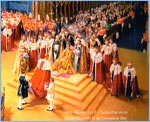 |
|
Today, owning a ruby can bring only good
fortune, for rubies of excellent quality are usually considered the most
expensive of gems. Gem-quality rubies over fifty carats are exceedingly
rare. The 15.97-carat Mogok ruby, set as a ring, sold at auction for a
quarter million dollars per carat. Elizabeth Taylors flamboyant third
husband, producer Mike Todd, showered his wife in jewels, including a
ruby necklace (and matching ruby gown) he bought for her to wear to the
premiere of Around the World in 80 Days,
|
|
| |
Compared with the radiant lore surrounding
the ruby, relatively little history is attached to the sapphire. Sapphires
come in an array of colors: deep blue, canary yellow, pink, lavender,
orange, green and purple. The largest sapphire, the "Gem of the Jungle,"
was found in 1929 and weighed 958 carats. It was cut into nine stones,
the largest of which weighed 66.50 carats.
While Cleopatra favored emeralds and holy men favored
rubies, the sapphire was the stone of choice for monarchs, including Charles
V of France, who wore a blue sapphire ring that he held next to his eyelids
to remove foreign particles from his eyes. The ancients ascribed calming
powers to sapphires and also believed that the stones provided mental
clarity.
The "Marriage Contract" was the
nickname given the sapphire and diamond bracelet that Wallis Simpson wore
when she married His Royal Highness, the Duke of Windsor; she also wore
a matching brooch and earrings. The "Stuart Sapphire," a 104-carat
flawless beauty was set in Queen Victoria's Imperial State Crown for her
coronation in 1838.
|
|
| |
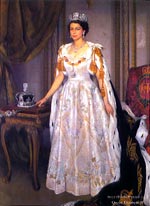 |
|
The oldest stone in the British Crown Jewels
was set in a ring for Edward the Confessor, King of England from 10/12
to 1066: the St. Edward Sapphire. Carder made a magnificent bracelet with
a 65.15-carat Kashmir sapphire set with diamonds and smaller sapphires;
the Art Deco masterpiece, worth a fortune, was stolen from an auction
exhibit in Milan in 1996. Countess Mona von Bismarck donated the 98.57-carat
"Bismarck Sapphire" to the Smithsonian Institution in
1967.
While rubies and sapphires are second only
to diamonds in hardness, the emerald's preciousness lies in something
more ephemeral: its inimitable color. The emerald is the most precious
and rarest variety of a mineral known as beryl.
|
|
| |
Due to their composition, emeralds can be
brittle. But a high-quality emerald, lusciously green, is so unique that
its
value can far exceed other gems of comparable quality.
The emerald is the gem of Venus, goddess of love.
It is not surprising then that many lovers seal their commitment to each
other not with a diamond, but with an emerald. The Duke of Windsor, for
example, presented his duchess with a 19,77-carat rectangular emerald
from Cartier London. The jewel was one half of one of the most fabulous
emeralds of all time, having once belonged to the Grand Mogul. The Parisian
jeweler Mauboussin owns one of the most famous emeralds, the 24.38-carat
"Napoleon," which was once a gift from Napoleon to Josephine
de Bauharnais.
|
|
| |
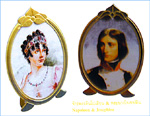 |
|
Colored stones mesmerize with their depth of color, their rich hues;
the diamond, however, dazzles with brilliance, unsurpassed sparkle.
As the hardest known substance, the diamond first
and foremost bespeaks power. Yes, diamonds are associated with love. Yes,
diamonds symbolize beauty, elegance and opulence. But a diamond is forever
and forever is invincible and powerful.
|
|
| |
Fine diamonds are superlative heirlooms.
Nothing can rival a diamond's beauty and durability. The Hindus believe
that diamonds bring good fortune. Diamonds are also said to bring the
wearer equilibrium and loyalty and these properties are believed to be
enhanced if the gem is received as a gift.
The world's most illustrious jewels are diamonds. Even
when another gem is the centerpiece, diamonds are typically used to accent
and emphasize colored stones. A diamond's value is determined by the 4
C's: color, clarity, carat weight and cut.
|
|
| |
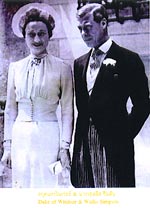 |
|
Van Cleef & Arpels specializes in fancy
colored diamonds mixed with gems of other hues. Creations include the
four-inch-high palm tree brooch from the 1940s and a contemporary multicolored
bracelet featuring diamonds with rubies and emeralds.
During jewelry's egalitarian Art Deco days, diamonds
and other precious gems were juxtaposed with semiprecious stones, creating
enormous range in the palette of colors available to the master jewelers.
That trend continued into the forties, when the jeweler Verdura was designing
for Hollywood's famed luminaries. Lauren Bacall, for example, favored
an aquamarine and diamond brooch.
|
|
| |
Throughout history, semiprecious stones
were given the royal treatment. King Tutankhamun wore a pendant comprised
of lapis lazuli, carnelian, chalcedony, turquoise, obsidian and diamond.
Mary, Queen of Scots, adored amethyst for its ability to cure melancholy.
Jane Seymour, Henry VIII's third wife, often wore a large peridot pendant
accented with garnet and sapphire that she believed protected her from
evil.
|
|
| |
 |
|
Moving into the twentieth century, Carrier
created an angular bib necklace of twisted gold rope set with amethysts,
turquoise and diamonds for the Duchess of Windsor. Verdura fashioned a
pomegranate brooch with faceted peridots and cabochon rubies set in gold
for the queen of all duchesses. Elvis Presley, the "King" of
rock and roll, sported an enormous aquamarine ring. (Aquamarines are "related"
to emeralds, derived from the same mineral.)
Virtually every stone has an enchanted lore. Birthstones.
Lucky stones. Amulets. Whether these mystical attributes are mythical
or miraculous does not matter. For who doesnt feel a bit more fortunate,
a tad more powerful when adorned with a dazzling diamond, a sensational
sapphire, or a ravishing ruby? -C
|
|
|

